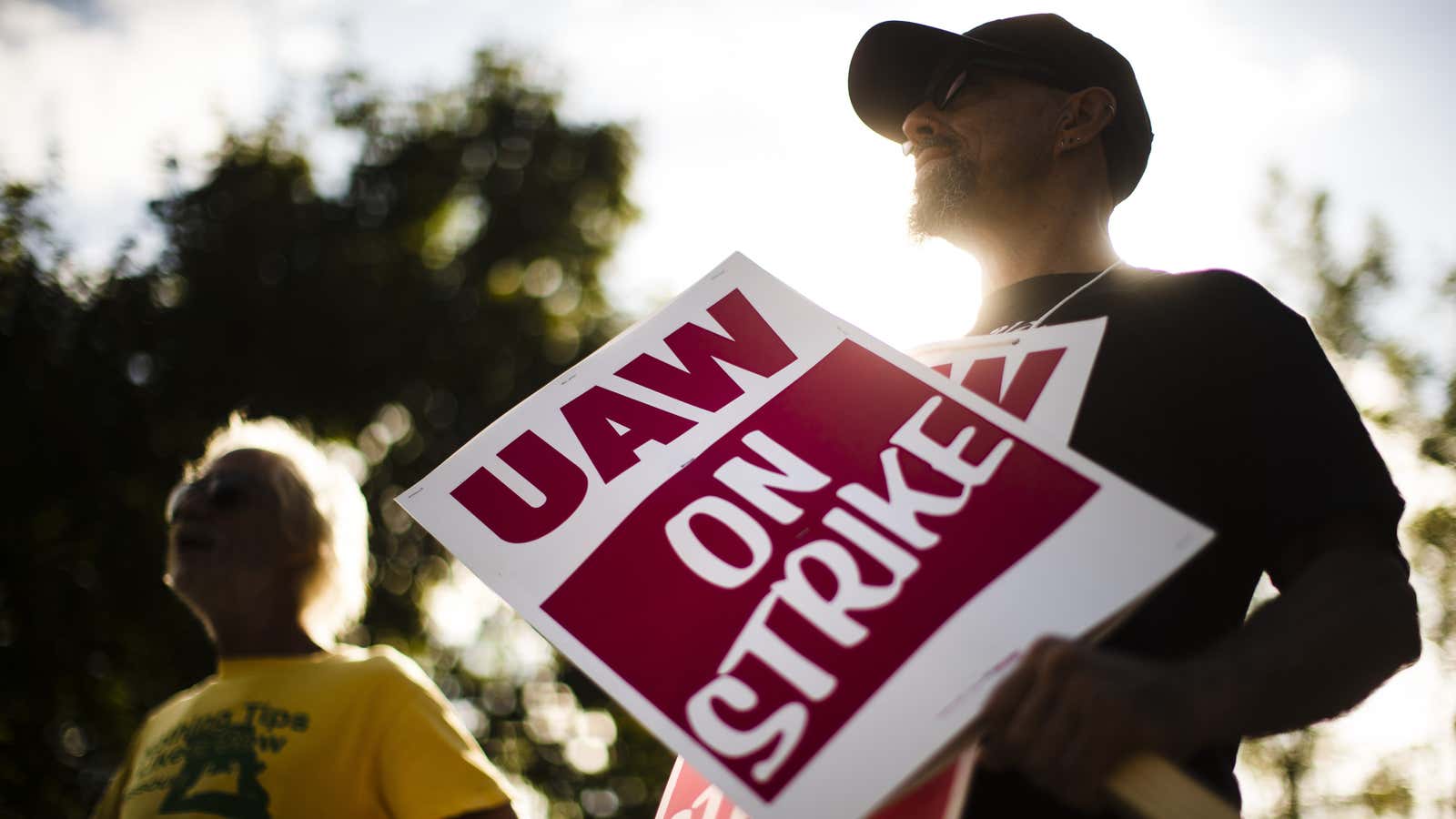Nearly 50,000 unionized workers at General Motors in the US went on strike this weekend in a bid to win better pay, caps on healthcare costs, and job security, among other basic demands.
In large and small ways, this battle, the largest US labor action since a 2007 strike at GM, will be felt by millions who work in the auto industry or are supported by it, especially if it lasts long enough to draw in workers at Ford and Fiat Chrysler. As it is, the strike by the United Auto Workers will cost GM about $50 million per day, Bloomberg reports. It also could bring severe cuts to household budgets for the families of employees on the picket lines, should the union move to pay members at the strike pay rate of $250 per week.
But the positive news for the workers is that this time around, the union should have unprecedented public support on its side. This year, Gallup found that 64% of Americans approve of unions, which is among the highest of approval ratings seen in the past 50 years, and a full 10 percentage points above the average approval rating for organized labor since 1967.
Sentiment has been moving in the same direction for Democrats, Republicans, and independent voters, Gallup found, with all three groups seeing rates jump by about 16 points since 2009, even as Republican approval ratings for unions remains lowest at 45%, compared to 82% among Democrats.
Employee activism is changing business as usual
Signs that we’re witnessing new, warmer attitudes toward unions and collective action in general aren’t limited to surveys. They’re literally everywhere, in almost every profession. Consider the increase in the collective employee activism we’re seeing in the name of pay equality, inclusion, and the environment, at places like Microsoft, Google, Facebook, and Amazon.
Meanwhile, large unions are finding their way into white-collar professions, including education, gaming, media, and tech. To be sure, the trend is small and still vulnerable, but grassroots mini-uprisings have been sparked enough to garner headlines.
Even the Business Roundtable, a lobbying group representing more than 180 CEOs of some of the largest US companies, has recently updated its definition of the purpose of a company to include employees as stakeholders, alongside stockholders, customers, and communities. Its guidance on investing in employees—which includes “compensating them fairly and providing important benefits” and “supporting them through training and education that help develop new skills for a rapidly changing world”—can be read as an indication that the country’s well-compensated business leaders and wealthiest households acknowledge that the degree of inequality we’re seeing in the US is simply not sustainable.
Indeed, there’s only so long that companies can stockpile profits or offer shareholder buybacks, and pay CEOs at mind-blowingly unfair ratios while asking rank-and-file employees to reduce their living costs, cover larger portions of health care, or take out massive loans to send their kids to college. Eventually, people will look for ways to collectively demand more of their share.
“We have UAW members who work long, hard hours and are still on public assistance. It’s shameful,” Gerald Kariem, Director of UAW Region 1D, based in Flint, Michigan, said in a statement about the GM strike.
GM, which is led by CEO Mary Barra (she’s also a Business Roundtable board member), has said it is disappointed in the union’s decision to strike, saying the company had been negotiating in good faith to meet employees’ demands.
It’s the movement’s turn to tend to its reputation
Unions fell sharply out of favor in the US during the 1980s, when Reaganomics redefined American corporate attitudes, instilling a belief that the strongest corporations were mean and lean, and should not be beholden to union demands. Only a truly free market could provide benefits for workers, including employment security and strong wages, went the argument. Unions became synonymous with waste and sludge that have no place in a free-market economy.
Perhaps even more significantly, unions were painted as a large lobby group like any other, rather than as advocates for the working class, Barry Eidlin, an assistant professor of sociology at McGill University, believes. “For decades now, labor’s status as a special interest has weakened unions’ legitimacy, eroded workers’ legal protections and constrained labor’s ability to act,” he writes in The Conversation.
But unencumbered capitalism has, arguably, not delivered, making space for unions to shake off old labels. And politicians on the left who advocate for a more mixed form of capitalism are benefitting from the new atmosphere.
The new challenge for the labor movement may be to hang onto its advantage—this blossoming reputation as a force for good—while not giving union critics too much material to work with.
